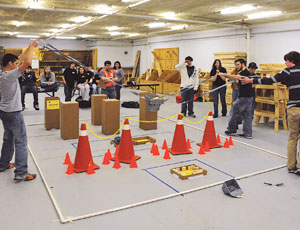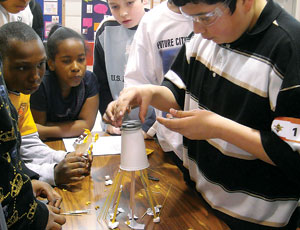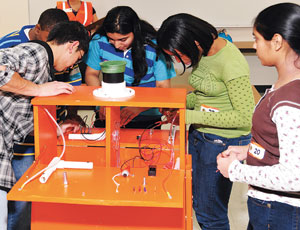Your assignment: Make a tool to separate a tray of golf balls and wood blocks into two piles without touching them. Transfer the piles across an obstacle course of orange cones, and drop them into designated boxes. Hurry up! Don’t step outside the boundary lines, or you’ll lose points.



Thousands of junior-high and high school students took on tasks like this one at 15 regional “Construction Challenge” competitive rallies held on Saturday, Feb. 7, across the U.S. and Canada. Their goal was to find creative solutions to real-life scenarios typical of construction sites or drawing tables. That, and the scholarship money at the end of the road.
Now in its second year, Construction Challenge is a career-education initiative designed to encourage and develop the next generation of workers across construction’s many facets. The program was founded by the Workforce Development Committee of Milwaukee-based Association of Equipment Manufacturers in partnership with nonprofit group Destination ImagiNation, Glassboro, N.J., which produces creative problem-solving and critical-thinking experiences that are custom-tailored to a variety of in-dustries for children and adults.
Program supporters are hard at work to expand its reach. John Malloy, an executive recruiter with long-standing career ties to equipment manufacturers, read about the Construction Challenge last year and decided to get involved. He organized and sponsored a team at his local high school, Hartford Union High School in Hartford, Wis., and served as a judge at the regional rally held in Milwaukee.
Malloy’s team won. “When given a challenge, it always surprises me how much imagination kids have,” he says. “It just needs to be fostered.” To raise the $5,000 needed to travel to the national competition, set for May 19-23 in Knoxville, Tenn., the team produced a DVD about the kids, the competition and how it has impacted them. Team members are sending DVDs to construction companies in hopes of obtaining a sponsorship.
Construction’s Challenge
Like other industries, the so-called “Silver Tsunami” created by the flood of retiring Baby Boomers has construction in a bind. AEM estimates that, with anticipated retirements, the industry will need to fill about 1 million jobs over the next four years, and that is without any extra government stimulus. “While our nation’s leaders are planning for the creation of millions of jobs, the Construction Challenge is one way our industry can help prepare for and invest in that future,” says AEM President Dennis Slater. “We also hope everyone has a little fun and gets inspired along the way.”
The day-long regional rallies were identical in format. The five- to seven-member teams, winnowed from smaller, local, school competitions, participated in three major challenges: The first was to create a poster presentation on an issue related to infrastructure. The second was to build a piece of equipment based on specific criteria, and the third was a simulated technical problem such as fixing a piece of broken machinery.
It was the second challenge that sent golf balls and wood blocks flying. Teams were given a box of materials including duct tape, tubing, cardboard, a pancake spatula and 30 minutes to construct a sorting and transporting device. In Chicago, most of the 23 teams enlarged their spatulas into some semblance of a scooper. Their transportation modes varied. One team loaded balls and blocks onto a chute and poured them into the right spot. Some teams fashioned containers and carried those to the finish line.
Many of the solutions were successful, but a few teams learned what did not work, like extending the length of the pancake spatula with flexible tubing: it could not be controlled. And if golf balls were loaded into a cardboard tube, they would roll out the other end if not sealed.
“This is an opportunity for our kids to show what they can do with very little,” says Bob Sokol, a physics and engineering teacher from King College Preparatory High School in Chicago and leader of two teams. “We see the students in ways we don’t see them in class—thinking on the fly and coming up with clever solutions. I am usually a little humbled by what kids half my age come up with.”
In addition to the major challenges, the event included several smaller, “instant” ones for students to tackle during their down time. One consisted of building a structure with 30 popsicle sticks, gluing it in 10 minutes and waiting to see how much weight it could bear before crashing. In Chicago, the number to beat was 215 lb.
Image Improves
The students represent a wide mix of cultural, economic and education diversity, says Diana Baldi, the Chicago rally leader. “Educationally, they included pre-engineering, college-bound high-school students; future technical or trade-school students; and students who were nearly flunking out of school before Construction Challenge,” she says. “Once they take a look at what the industry has to offer and they develop some confidence with problem-solving skills, they realize there is hope for a meaningful career for them.”
Founded in 1983, Destination ImagiNation develops and implements a worldwide challenge program under its own brand that enrolls 300,000 students in 45 countries. It also offers customized programming. The group’s portfolio includes an HIV education and risk-reduction program in South Africa and a nutrition and fitness program in collaboration with the National Dairy Council in the U.S.
Construction Challenge is still a recent venture, but early reviews are encouraging. Last year’s 1,200 participants were surveyed twice. Before challenge season began, 12% of the group had a favorable impression of the construction industry as a possible career choice. After the season, the favorable rate jumped to 78%.
“Even if they don’t go into the industry, there are 1,000 more kids who now have an appreciation for it,” says Destination ImagiNation President Rusty McCarty. This year, 2,300 students are participating, and sponsors hope for similar results, he adds. After the regionals, 55 teams advanced to compete in championship finals. Winners will receive scholarship money, electronics and gift cards.
At the February rally in Chicago, held at the carpenters’ union local training center, the teams from King Prep will not advance to the finals. Neither will Highland Park High School. But students say the day was still worthwhile.
“I liked seeing the challenges come together and be completed in such a short amount of time, and how we could come up with a way to do a task we normally would not do,” says Highland Park student J.J. Sechan. Another team member, Adam Hartman, adds, “I learned that it is more fun to work as a team, than to work as your best self.”


Post a comment to this article
Report Abusive Comment